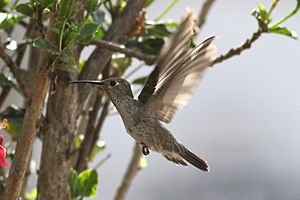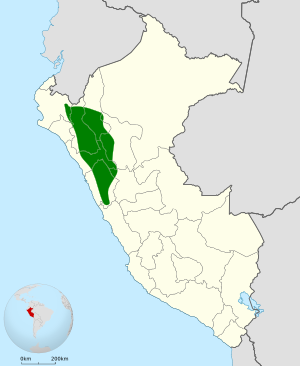Spot-throated hummingbird facts for kids
Quick facts for kids Spot-throated hummingbird |
|
|---|---|
 |
|
| Conservation status | |
| Scientific classification | |
| Genus: |
Thaumasius
|
| Species: |
taczanowskii
|
 |
|
| Synonyms | |
|
Leucippus taczanowskii |
|
The spot-throated hummingbird (Thaumasius taczanowskii) is a small, colorful bird. It belongs to the hummingbird family. This special bird lives mostly in Peru. Some people think it might also live in Ecuador, but this is not fully confirmed.
Contents
How Scientists Name This Bird
Scientists group living things to understand them better. This is called taxonomy. The spot-throated hummingbird was once in a group called Leucippus. But a study in 2014 showed that this group was not quite right. So, scientists moved the spot-throated hummingbird to a new group. This new group is called Thaumasius. Most bird experts now agree with this change.
This hummingbird is also monotypic. This means it is the only species in its group.
What It Looks Like
The spot-throated hummingbird is a small bird. It is about 11.5 to 12.5 centimeters (4.5 to 4.9 inches) long. It weighs about 6 to 7 grams (0.21 to 0.25 ounces). Both male and female birds look very similar.
They have a black beak that curves a little. Sometimes, the lower part of the beak can be gray-brown or even yellow. Their upper body is grayish-green to bronze-green. Their head feathers are bronze. The feathers on their upper tail are also bronze.
Their inner tail feathers are grayish-green. The outer tail feathers are more grayish. These outer feathers also have a bronze band near the end. Their belly is dull gray. They have golden-green spots on their chin, throat, and sides. The feathers under their tail are light brown with white edges.
Where It Lives and Its Home
The spot-throated hummingbird is mainly found in Peru. It lives on the western side of the Andes mountains. It also lives in the Marañon River valley. This area stretches from near the Ecuador border down to the Ancash Department in Peru. Some people have seen it in southern Ecuador. But these sightings are not fully proven yet.
This hummingbird likes dry, scrubby areas. It also lives at the edges of forests where trees lose their leaves. In the Andes, it usually lives between 900 and 1900 meters (2,950 and 6,230 feet) high. Sometimes, it can be found as low as 200 meters (660 feet). In the Marañon valley, it lives between 350 and 2800 meters (1,150 and 9,190 feet) high.
How It Behaves
Movement
Scientists do not know much about how this hummingbird moves. It is not clear if it travels to different places during the year.
Feeding Habits
The spot-throated hummingbird eats nectar from flowers. It finds nectar from low plants up to medium-height plants. We do not know all the plants it likes. But it is known to feed from Inga trees, Agave plants, and banana plants (Musa). Besides nectar, it also catches small bugs while flying.
Reproduction
Scientists have not yet described how the spot-throated hummingbird breeds. Its nest has also not been found or described.
What It Sounds Like
The song of the spot-throated hummingbird is quite complex. It sounds like a mix of "chips" and "wheezing electric warbles." It also makes dry chattering sounds and "tip" notes.
Its Conservation Status
The IUCN (International Union for Conservation of Nature) has looked at the spot-throated hummingbird. They have listed it as "Least Concern." This means it is not currently in danger of disappearing. It lives in a fairly large area. However, we do not know how many of these birds there are. We also do not know if their numbers are going up or down. No major threats have been found for this bird right now. It is thought to be quite common. Human activities do not seem to harm the spot-throated hummingbird much, at least for now.
See also
 In Spanish: Colibrí de Taczanowski para niños
In Spanish: Colibrí de Taczanowski para niños


